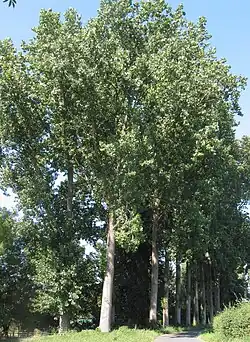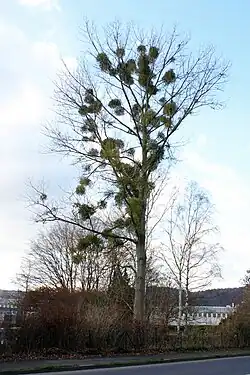Populus × canadensis
| Populus × canadensis | |
|---|---|

| |
| Scientific classification | |
| Kingdom: | Plantae |
| Clade: | Tracheophytes |
| Clade: | Angiosperms |
| Clade: | Eudicots |
| Clade: | Rosids |
| Order: | Malpighiales |
| Family: | Salicaceae |
| Genus: | Populus |
| Section: | Populus sect. Aigeiros |
| Species: | P. × canadensis
|
| Binomial name | |
| Populus × canadensis | |
| Synonyms[1] | |
|
List
| |
Populus × canadensis, known as the hybrid black poplar, Canadian poplar or Carolina poplar, is an artificial hybrid between Populus nigra from Europe and Populus deltoides from North America, which arose when the two parent species were first brought together in cultivation in France soon after 1700.[2][3] It is a vigorous, broadly columnar, deciduous tree growing to 40–45 m (131–148 ft), which is commonly used in plantation forestry and by landscape architects. The tallest reliably measured, near the Weltenburg Abbey in Kelheim, Germany, is 47 metres tall, and the stoutest, in Baak in the Netherlands, is 8.5 metres girth.[4]
Description
It is intermediate between its parents in characters, with leaves deltoid (triangular) but with a less broad base than P. deltoides and often somewhat acute at the base, as in P. nigra; the leaves are 8–14 cm long and 8–11 cm wide. As with all poplars, it is dioecious, with separate male and female trees; the sex of an individual is often an important clue to identifying which cultivar it is. The pollen catkins are red, the seed catkins green, and opening when mature to shed their small seeds embedded in cotton-like fluff.[5]
Cultivars
Numerous cultivars have been selected, mostly for forestry use; the most significant listed below in order of naming:[2][5]
- 'Serotina' 1750, France. From Latin, "late", named from its late leaf bud opening, not until late May or June; the first produced, it is very vigorous, and easily recognised by its slanting trunk and few, large branches. Male. To 42 m tall.[2]
- 'Marilandica' 1800. An early clone, now rarely found. Female. To 40 m tall.[2]
- 'Regenerata' (railway poplar) 1814, France. From Latin, "regenerating", as it pollards well; the English name from being much planted along railway lines in England in the 20th century. Leafs out a month earlier than 'Serotina', but similar in crown shape. Female. To 40 m tall.[2][5]
- 'Eugenei' 1832, Metz, France. One parent was Populus nigra 'Italica' (Lombardy poplar), and it inherits a narrow crown from this, though much less obvious than its parent. Male.[5]
- 'Serotina Aurea' (syn. 'Aurea'; golden poplar[6]) 1871, Belgium. From Latin, "gold", referring to the yellowish foliage. Slower-growing, and only reaching around 30 m.[5] It has won the Royal Horticultural Society's Award of Garden Merit.[7][8]
- 'Robusta' 1895, France. From Latin, "robust, fast-growing". A much straighter tree than 'Serotina', growing vertical, and with more numerous but smaller and more regular branching and narrow-crowned; very vigorous when young (2–2.5 m per year). Important in forestry. Male.[2][9]
- 'Gelrica' c.1900, Netherlands. Male. Particularly vigorous in trunk diameter growth; the stoutest known specimen is this cultivar.[4]
Ecology
Hybrid black poplar is very susceptible to attack by mistletoe (Viscum album), to which its European parent P. nigra is highly resistant; heavy mistletoe infestation on a poplar is a reliable indicator that the poplar is P. × canadensis and not P. nigra.[10][11][12]

References
- ^ "Populus × canadensis Moench". Plants of the World Online. Board of Trustees of the Royal Botanic Gardens, Kew. 2017. Retrieved 21 December 2020.
- ^ a b c d e f Mitchell, Alan F.; Mitchell, Alan (1996). Alan Mitchell's Trees of Britain. Whitman Publishing & Distribution Company. pp. 273–278. ISBN 0-00-219972-6.
- ^ "Populus x canadensis Canadian Poplar, Carolina Poplar PFAF Plant Database". www.pfaf.org. Retrieved 2016-04-18.
- ^ a b "The thickest, tallest, and oldest Hybrid Black Poplars (Populus × canadensis)". Monumental trees. Retrieved 2025-08-05.
- ^ a b c d e Mitchell, Alan F. (1974). A Field Guide to the Trees of Britain and Northern Europe. London: Collins. pp. 186–187. ISBN 0-00-212035-6.
- ^ "Golden Poplar". National Trust (Australia). Retrieved 31 May 2019.
- ^ "RHS Plantfinder - Populus × canadensis 'Aurea'". Retrieved 14 May 2018.
- ^ "AGM Plants - Ornamental" (PDF). Royal Horticultural Society. July 2017. p. 82. Retrieved 14 May 2018.
- ^ "Populus x canadensis 'Robusta'". landscape architect's pages. Retrieved 2016-04-18.
- ^ "Leitfaden für das genetische Monitoring Schwarz-Pappel (Populus nigra L.)" (PDF) (in German). Retrieved 2025-08-05.
- ^ Kołodziejek, Jeremi; Patykowski, Jacek; Kołodziejek, Rafał (2012-12-27). "Distribution, frequency and host patterns of European mistletoe (Viscum album subsp. album) in the major city of Lodz, Poland". Biologia. 68 (1). Springer Science and Business Media LLC: 55–64. doi:10.2478/s11756-012-0128-4. ISSN 0006-3088. Retrieved 2025-08-05.
- ^ Anderson, M.; Crampin, J. (1994). "The native Black Poplar in Somerset, particularly in Taunton Deane" (PDF). Somerset Archaeology and Natural History. 138: 235–245. Retrieved 5 August 2025.